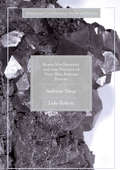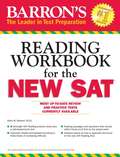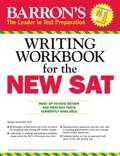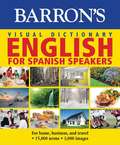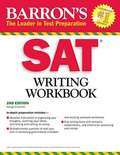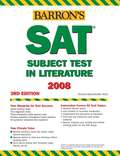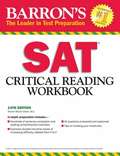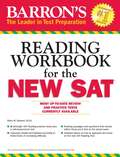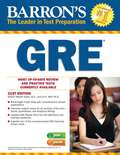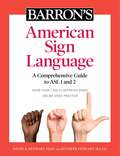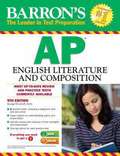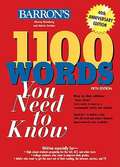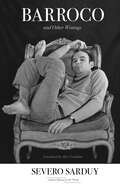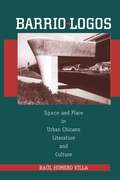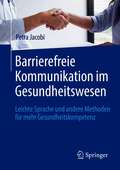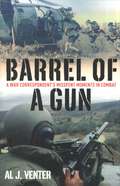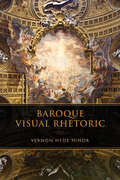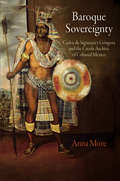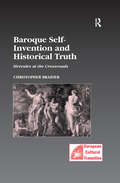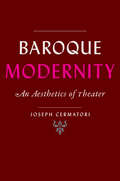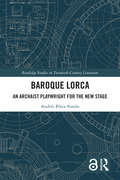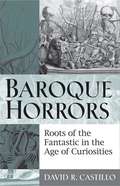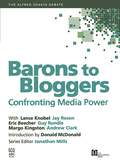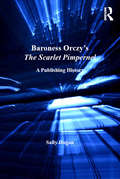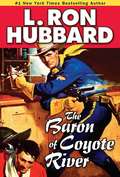- Table View
- List View
Barry MacSweeney and the Politics of Post-War British Poetry: Seditious Things (Modern and Contemporary Poetry and Poetics)
by Luke RobertsThis book examines the literary impact of famed British poet, Barry MacSweeney, who worked at the forefront of poetic discovery in post-war Britain. Agitated equally by politics and the possibilities of artistic experimentation, Barry MacSweeney was ridiculed in the press, his literary reputation only recovering towards the end of his life which was cut short by alcoholism. With close readings of MacSweeney alongside his contemporaries, precursors, and influences, including J. H. Prynne, Shelley, Jack Spicer, and Sylvia Plath, Luke Roberts offers a fresh introduction to the field of modern poetry. Richly detailed with archival and bibliographic research, this book recovers the social and political context of MacSweeney's exciting, challenging, and controversial impact on modern and contemporary poetry.
Barron's: Reading Workbook For The New SAT
by Sharon Weiner Green Brian W. StewartThis new edition concentrates on the new 2016 SAT's Reading Test with exercises reflecting all of the new SAT question types: reading comprehension, understanding words used in context, and graphical analysis. Exercises are divided according to three levels of increasing difficulty, labeled from A to C . Features a helpful diagnostic test and 3 full-length Reading practice tests. All questions are answered and explained. Students who can answer all level C questions are ready to excel on the actual exam The workbook also presents test-taking tips and vocabulary review.
Barron's Writing Workbook for the New SAT, 4th edition
by George Ehrenhaft Ed. D.This thoroughly revised edition of Barron’s Writing Workbook for the New SAT prepares students for the writing sections of the newly redesigned SAT: The SAT Writing and Language Test and The SAT Essay. It includes:
Barron's Visual Dictionary:English for Spanish Speakers:For Home, For Business, and Travel (Barron's Visual Dictionaries)
by Pons Editorial TeamTravelers, students, and lovers of language will find this little visual dictionary to be indispensable. Small enough to slip into a purse or satchel, it includes thousands of common words identified by pictures and defined bilingually. Barron's Visual Dictionary: English for Spanish Speakers features approximately 15,000 words and concepts sorted into 13 clearly formatted and color-coded categories. Color-coded page headers make it quick and easy to find words in each category, from people, food, and communication, to education, leisure, and sports. This book also features:3,000 full-color pictures that provide helpful visualization for instant recognitionHelpful vocabulary boxes throughout to expand on abstract terms not covered by the picturesA bilingual index for quick and easy referenceIdeal for beginner and intermediate speakers, Barron’s Visual Dictionaries are also available in Spanish, French, and Italian.
Barron's SAT Writing Workbook (2nd Edition)
by George EhrenhaftThe two-part Writing Test is an important component of the SAT, and this workbook offers college-bound students comprehensive preparation for both parts. Instruction in organizing one's thoughts, drafting, and editing an essay includes advice on completing the essay within the SAT's time limitation. This workbook also presents five writing tests with answers, explanations, and criteria for analyzing and assessing written essays.
Barron's SAT Subject Test in Literature 2007
by Christina Myers-ShafferComprehensive preparation for the test formerly called SAT II: Literature is presented here with seven practice tests, two diagnostic tests, and three interpretive skills practice sets. Students will also find reference material to help them develop critical reading skills, analyze literature, and write papers. A helpful chapter titled "Writing to Learn" teaches critical reading skills and the literary elements by showing students how to develop their own writing skills.
Barron's SAT Critical Reading Workbook (14th Edition)
by Sharon Weiner Green Mitchel WeinerThis newly updated 14th edition concentrates on the SAT's Critical Reading section with exercises reflecting both SAT question types: sentence completion and reading comprehension.
Barron's Reading Workbook for the NEW SAT
by Brian Stewart M.Ed.This edition concentrates on the Reading Test with exercises reflecting all of the new SAT question types: reading comprehension; understanding words used in context; and graphical analysis. Exercises are divided according to three levels of increasing difficulty and labeled from A to C. The book features a helpful diagnostic test and 3 full-length Reading practice tests. All questions are answered and explained. Students who can answer all level C questions are ready to excel on the actual exam. The workbook also presents test-taking tips and vocabulary review.
Barron's GRE 21st Edition
by Sharon Weiner Green Ira K. WolfThis newly revised and updated manual presents a test overview of the GRE, test-taking advice, and a timetable for a typical computer-based test. Added features include-- A diagnostic test with an answer key and answer explanations A verbal reasoning review with practice questions in sentence completion and reading comprehension An analytical writing review with scoring guidelines and practice exercises A quantitative reasoning review that includes general math strategies, discrete quantitative questions, quantitative comparison questions, and data interpretation questions Two full-length model GRE tests with answer keys and answer explanations.
Barron's American Sign Language: A Comprehensive Guide to ASL 1 and 2 with Online Video Practice
by David A. Stewart Jennifer StewartBarron&’s American Sign Language is a brand-new title on ASL that can be used in the classroom, as a supplemental text to high school and college courses, or for anyone who wants to learn proper ASL.The only book with comprehensive instruction and online graded video practice quizzes, plus a comprehensive final video exam.Content includes topics on the Deaf culture and community, ASL Grammar, fingerspelling, combining signs to construct detailed sentences, Everyday ASL, and much more.More than 1,000 illustrations of signs with instructions on movement--step-by-step with dialogue, tip boxes, and practice exercises and quizzes throughout to reinforce retention and to track your progress.
Barron's AP English Literature and Composition (5th Edition)
by George Ehrenhaft Ed.D.In-depth preparation for the AP English Literature and Composition exam includes: Five full-length practice AP exams with all questions answered and explained Additional sample questions with answers covering poetry and prose fiction A review of test topics covering details test takers need to know about poetry, fiction, and drama Sample student essays with critiques of their strengths and weaknesses A detailed glossary defining 175 literary and rhetorical terms Updated guidelines for determining final AP exam score The manual can be purchased alone or with an optional CD-ROM that presents two additional full-length practice tests with automatic scoring and fully explained answers. BONUS! An exclusive online exam included with the purchase of the book or the book with CD-ROM!
Barron's 1100 Words You Need to Know (Fifth Edition)
by Murray Bromberg Melvin GordonUpdated to meet the needs of students preparing for the latest versions of the SAT and ACT college entrance tests, the new edition of this helpful, longtime best-selling book features word lists with definitions, analogy exercises, word games, and words-in-context exercises. A special feature is the authors’ Panorama of Words, in which each of the book’s 1110 words is presented in a sentence from a well-known novel, play, poem, or other literary source. A new “Bonus Materials” section commemorates this book’s 40th Anniversary as a leader in vocabulary building and test preparation.
Barroco and Other Writings (Cultural Memory in the Present)
by Severo SarduySevero Sarduy was among the most important figures in twentieth-century Latin American fiction and a major representative of the literary tendency to which he gave the name Neobaroque. While most of Sarduy's literary work is available in English, his theoretical writings have largely remained untranslated. This volume—presenting Sarduy's central theoretical contribution, Barroco (1974), alongside other related works—remedies that oversight. Barroco marks a watershed in postwar thought on the Baroque, both in French post-structuralism and in the Latin American context. Sarduy traces a double history, reading events in the history of science alongside developments in the history of art, architecture, and literature. What emerges is a theory of the Baroque as decentering and displacement, as supplement and excess, a theory capacious enough to account for the old European Baroque as well as its queer, Latin American and global futures. In addition to Barroco, this volume includes texts spanning Sarduy's career, from 1960s essays published originally in Tel Quel to late works from the 1980s and '90s. It thus offers a complete picture of Sarduy's thinking on the Baroque.
Barrio-Logos: Space and Place in Urban Chicano Literature and Culture
by Villa Raúl HomeroStruggles over space and resistance to geographic displacement gave birth to much of Chicano history and culture. In this pathfinding book, Raúl Villa explores how California Chicano/a activists, journalists, writers, artists, and musicians have used expressive culture to oppose the community-destroying forces of urban renewal programs and massive freeway development and to create and defend a sense of Chicano place-identity.
Barrierefreie Kommunikation im Gesundheitswesen: Leichte Sprache und andere Methoden für mehr Gesundheitskompetenz
by Petra JacobiDas Buch stellt die Möglichkeiten vor, allen Menschen den Zugang zu Kommunikation und Information im medizinischen Kontext ohne fremde Hilfe zugänglich zu machen. Die Autorin stellt die Grundlagen und Maßnahmen Barrierefreier Kommunikation wie Leichte Sprache, Unterstützte Kommunikation oder Digitale Barrierefreiheit vor und gibt Fachkräften im Gesundheitsbereich Tipps zur Anwendung. Sie lernen, wie Sie medizinische Sachverhalte leicht verständlich, zielgruppengerecht und patientenzentriert vermitteln, um Compliance und Adhärenz zu fördern.
Barrel of a Gun: A War Correspondent’s Misspent Moments in Combat
by Al Venter<p>“Anybody who says that the pen is mightier than the sword hasn’t spent time in Somalia, or in Beirut during its bloody heyday.” So begins this fascinating memoir of a journalist, filmmaker, and just plain raconteur who has made a career of examining warfare—on the ground and as the bullets are flying. While the average citizen is aware of violent conflicts broiling all around the globe, Al J. Venter—from some strange compulsion unexplainable even by him—has felt the need to see them all in person, preferably at the center of the action. <p>Born in South Africa, Venter has found no shortage of horrific battles on his own continent, from Rhodesia to Biafra, and Angola to Somalia. He has ridden with the legendary merc group Executive Outcomes, jumped into combat with South Africa’s crack Parachute Regiment (the Parabats), and traipsed the jungles with both guerrillas and national troops under whichever strongman in the country then held power. During Sierra Leone’s civil war he flew in the government’s lone Mi-24 Hind gunship as it blasted apart rebel villages and convoys, his complaint being that the Soviet-made craft leaked when it rained. <p>In the Mideast he went into southern Lebanon with the invading Israeli army as it encountered resistance from multiple Muslim groups, including the newly formed Hezbollah. Curious about the other side of the hill, he joined up with General Aoun’s Christian militias while that conflict was at its height. Touching down in Croatia during the Balkan wars, and in Congo during their perpetual one, as well as the Uganda of Idi Amin, Venter never lost his lust for action, even as he sometimes had to put down his camera or notebook to pick up an AK-47.</p>
Baroque Visual Rhetoric
by Vernon Hyde MinorIntricate, expressive, given to grandeur and even excess, Baroque art as a style is inseparable from the meanings it seeks to convey. Vernon Hyde Minor's Baroque Visual Rhetoric probes this combination of style and message and - equally importantly - the methodological basis on which the critical art historian comes to establish that meaning.Drawing on a breathtaking range of critical literature, from the German founders of art history as an academic discipline to Heidegger, Derrida, and de Man, Minor considers the issue through a series of Baroque masterpieces: Bernini's Baldacchino in St. Peter's Basilica, the statues in the church of San Giovanni in Laterano, Borromini's church of Sant'Ivo alla Sapienza, Baciccio's frescoes in the church of Il Gesù, the paintings of Philippe de Champaigne, and the Corsini Chapel in San Giovanni in Laterano.
Baroque Sovereignty: Carlos de Siguenza y Gongora and the Creole Archive of Colonial Mexico
by Anna MoreIn the seventeenth century, even as the Spanish Habsburg monarchy entered its irreversible decline, the capital of its most important overseas territory was flourishing. Nexus of both Atlantic and Pacific trade routes and home to an ethnically diverse population, Mexico City produced a distinctive Baroque culture that combined local and European influences. In this context, the American-born descendants of European immigrants—or creoles, as they called themselves—began to envision a new society beyond the terms of Spanish imperialism, and the writings of the Mexican polymath Carlos de Sigüenza y Góngora (1645-1700) were instrumental in this process. Mathematician, antiquarian, poet, and secular priest, Sigüenza authored works on such topics as the 1680 comet, the defense of New Spain, pre-Columbian history, and the massive 1692 Mexico City riot. He wrote all of these, in his words, "out of love for my patria."Through readings of Sigüenza y Góngora's diverse works, Baroque Sovereignty locates the colonial Baroque at the crossroads of a conflicted Spanish imperial rule and the political imaginary of an emergent local elite. Arguing that Spanish imperialism was founded on an ideal of Christian conversion no longer applicable at the end of the seventeenth century, More discovers in Sigüenza y Góngora's works an alternative basis for local governance. The creole archive, understood as both the collection of local artifacts and their interpretation, solved the intractable problem of Spanish imperial sovereignty by establishing a material genealogy and authority for New Spain's creole elite. In an analysis that contributes substantially to early modern colonial studies and theories of memory and knowledge, More posits the centrality of the creole archive for understanding how a local political imaginary emerged from the ruins of Spanish imperialism.
Baroque Self-Invention and Historical Truth: Hercules at the Crossroads (Studies in European Cultural Transition #23)
by Christopher BraiderIn his monumental study, Christopher Braider explores the dialectical contest between history and truth that defines the period of cultural transition called the 'baroque'. For example, Annibale Carracci's portrayal of the Stoic legend of Hercules at the Crossroads departs from earlier, more static representations that depict an emblematic demigod who has already rejected the fallen path of worldly Pleasure for the upward road of heroic Virtue. Braider argues that, in breaking with tradition in order to portray a tragic soliloquist whose dominant trait is agonized indecision, Carracci joins other baroque artists, poets and philosophers in rehearsing the historical dilemma of choice itself. Carracci's picture thus becomes a framing device that illuminates phenomena as diverse as the construction of gender in baroque painting and science, the Pauline ontology of art in Caravaggio and Rembrandt, the metaphysics of baroque soliloquy and the dismantling of Cartesian dualism in Cyrano de Bergerac and Pascal.
Baroque Modernity: An Aesthetics of Theater (Hopkins Studies in Modernism)
by Joseph CermatoriA groundbreaking study on the vital role of baroque theater in shaping modernist philosophy, literature, and performance.Winner, Helen Tartar First Book Subvention AwardBaroque style—with its emphasis on ostentation, adornment, and spectacle—might seem incompatible with the dominant forms of art since the Industrial Revolution, but between 1875 and 1935, European and American modernists connected to the theater became fascinated with it. In Baroque Modernity, Joseph Cermatori argues that the memory of seventeenth-century baroque stages helped produce new forms of theater, space, and experience around the turn of the twentieth century. In response, modern theater helped give rise to the development of the baroque as a modern philosophical idea. The book focuses on avant-gardists whose writing takes place between theory and performance: philosophical theater-makers and theatrical philosophers including Friedrich Nietzsche, Stéphane Mallarmé, Walter Benjamin, and Gertrude Stein. Moving between page and stage, this study tracks the remnants of seventeenth-century theater through modernist aesthetics across an array of otherwise disparate materials, including modern opera, Bertolt Brecht's Epic Theater, poetic tragedies, and miracle plays. By reexamining the twentieth century's engagements with Gianlorenzo Bernini, William Shakespeare, Claudio Monteverdi, Calderón de la Barca, and other seventeenth-century predecessors, the book delineates an enduring tradition of baroque performance. Along the way, Cermatori expands our familiar narratives of "the modern" and traces a history of theatricality that reverberates into the twenty-first century. Baroque Modernity will appeal to readers in a wide array of disciplines, including comparative literature, theater and performance, art and music history, intellectual history, and aesthetic theory.
Baroque Lorca: An Archaist Playwright for the New Stage (Routledge Studies in Twentieth-Century Literature)
by Andrés Pérez-SimónBaroque Lorca: An Arcaist Playwright for the New Stage defines Federico García Lorca’s trajectory in the theater as a lifelong search for an audience. It studies a wide range of dramatic writings that Lorca created for the theater, in direct response to the conditions of his contemporary industry, and situates the theory and praxis of his theatrical reform in dialogue with other modernist renovators of the stage. This book makes special emphasis on how Lorca engaged with the tradition of Spanish Baroque, in particular with Cervantes and Calderón, to break away from the conventions of the illusionist stage. The five chapters of the book analyze Lorca’s different attempts to change the dynamics of the Spanish stage from 1920 to his assassination in 1936: His initial incursions in the arenas of symbolist and historical drama (The Butterfly’s Evil Spell, Mariana Pineda); his interest in puppetry (The Billy-Club Puppets and In the Frame of Don Cristóbal) and the two ‘human’ farces The Shoemaker’s Prodigious Wife and The Love of Don Perlimplín and Belisa in the Garden; the central piece in his project of ‘impossible’ theater (The Public); his most explicitly political play, one that takes the violence to the spectators’ seats (The Dream of Life); and his three plays adopting, an altering, the contemporary formula of ‘rural drama’ (Blood Wedding, Yerma and The House of Bernarda Alba).
Baroque Horrors: Roots of the Fantastic in the Age of Curiosities
by David R. Castillo"Baroque Horrors is a textual archeologist's dream, scavenged from obscure chronicles, manuals, minor histories, and lesser-known works of major artists. Castillo finds tales of mutilation, mutation, monstrosity, murder, and mayhem, and delivers them to us with an inimitable flair for the sensational that nonetheless rejects sensationalism because it remains so grounded in historical fact." ---William Egginton, Johns Hopkins University. Baroque Horrors turns the current cultural and political conversation from the familiar narrative patterns and self-justifying allegories of abjection to a dialogue on the history of our modern fears and their monstrous offspring. When life and death are severed from nature and history, "reality" and "authenticity" may be experienced as spectator sports and staged attractions, as in the "real lives" captured by reality TV and the "authentic cadavers" displayed around the world in the Body Worlds exhibitions. Rather than thinking of virtual reality and staged authenticity as recent developments of the postmodern age, Castillo looks back to the Spanish baroque period in search for the roots of the commodification of nature and the horror vacui that accompanies it. Aimed at specialists, students, and readers of early modern literature and culture in the Spanish and Anglophone traditions as well as anyone interested in horror fantasy, Baroque Horrors offers ways to rethink broad questions of intellectual and political history and relate them to the modern age. David Castillo is Associate Professor and Director of Graduate Studies in the Department of Romance Languages and Literatures at the University at Buffalo, SUNY.
Barons To Bloggers: Confronting Media Power
by Mills, JonathanWhatever one thinks of Rupert Murdoch or his ethics, when a mogul of his stature stands on a public platform and predicts the end of God-like media figures telling people what's important, you begin to realise that there's something seismic going on in the world of communications. Seismic, but unpredictable. -Eric Beecher, Publisher, crikey.com Media power is undergoing a massive transformation. Is the Internet undermining the authority of traditional news institutions? And will it fulfil our expectations of greater democracy? In a provocative and incisive debate, Barons to Bloggers brings together prominent international and Australian media commentators to examine what is shaping up to become the radical upheaval of the old hierarchies of news and opinion. Contributors: Lance Knobel, former Program Director, World Economic Forum Jay Rosen, Associate Professor of Journalism, New York University Donald McDonald, Chairman, Australian Broadcasting Corporation Eric Beecher, Publisher, crikey.com Guy Rundle, writer and Executive Producer, ABC TV Margo Kingston, political commentator and Editor, SMH's Webdiary Andrew Clark, Australian Financial Review journalist, former Editor, Sun-Herald
Baroness Orczy's The Scarlet Pimpernel: A Publishing History (Ashgate Studies In Publishing History: Manuscript, Print, Digital Ser.)
by Sally DuganSince its publication in 1905, The Scarlet Pimpernel has experienced global success, not only as a novel but in theatrical and film adaptations. Sally Dugan charts the history of Baroness Orczy's elusive hero, from the novel's origins through its continuing afterlife, including postmodern appropriations of the myth. Drawing on archival research in Britain, the United States and Australia, her study shows for the first time how Orczy's nationalistic superhero was originally conceived as an anarchist Pole plotting against Tsarist Russia, rather than a counter-revolutionary Englishman. Dugan explores the unique blend of anarchy, myth and magic that emerged from the story's astonishing and complex beginnings and analyses the enduring elements of the legend. To his creator, the Pimpernel was not simply a swashbuckling hero but an English gentleman spreading English values among benighted savages. Dugan investigates the mystery of why this imperialist crusader has not only survived the decline of the meta-narratives surrounding his birth, but also continues to enthrall a multinational audience. Offering readers insights into the Pimpernel's appearances in print, in film and on the stage, Dugan provides a nuanced picture of the trope of the Scarlet Pimpernel and an explanation of the phenomenon's durability.
Baron of Coyote River, The
by L. Ron HubbardExperience the Old West. Lance Gordon killed his father's murderer in a fair fight, but now he's got a price on his head and has been running from the law ever since. Cornered by men of the US Cavalry in Santos, Lance gets rescued by a mystery man who convinces him to join forces and go after a notorious cattle rustler up the infamous Coyote River. Even together the pair stands barely a chance of bringing the gang of thieves to account, much less dealing with the soldiers still hot on their trail. ALSO INCLUDES THE WESTERN STORY "REIGN OF THE GILA MONSTER""Heart-racing plot charges at the speed of thrumming hooves."--Library Journal* An International Book Awards Finalist
